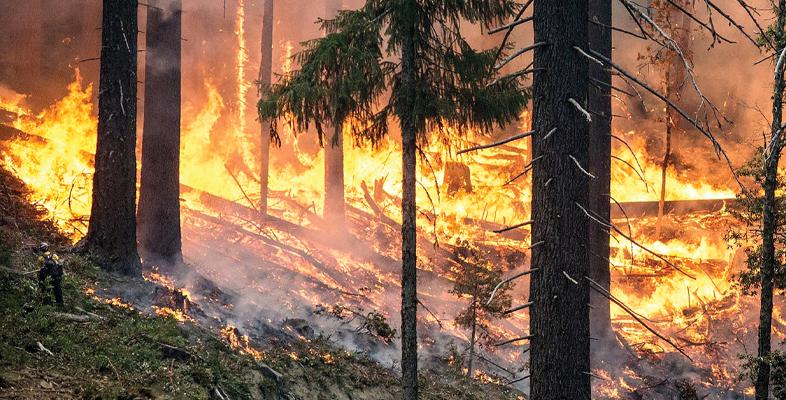Wildfire Ecology: Examining the Environmental Destruction of the LA Fires
In recent years, wildfires have ravaged vast stretches of land across the West Coast, leaving a profound mark on ecosystems and communities alike. The recent fires in Los Angeles serve as a stark reminder of the escalating intensity of these natural disasters, fueled by a changing climate and urban encroachment into wildfire-prone areas. Researchers at Ohio University are delving into the complex dynamics of wildfire ecology, uncovering the intricate relationships between these catastrophic events and the environment. As the flames consume habitats and threaten biodiversity, understanding the ecological consequences of such fires becomes imperative. This article explores the devastating impact of the LA fires, highlighting the urgent need for innovative approaches to wildfire management, conservation, and recovery in the face of an increasingly volatile future.
Understanding the Ecological Impact of Wildfires in Los Angeles
The recent wildfires in Los Angeles have sparked significant concern regarding their ecological consequences. These blazes not only devastate urban areas but also profoundly affect the region’s delicate ecosystems. Wildfires often lead to a rapid loss of biodiversity, which can take decades to recover. Flora and fauna that once thrived in these habitats may find their populations diminished, or worse, entirely eradicated. As environments change, invasive species may take advantage of the weakened systems, further complicating recovery efforts.
Moreover, the aftermath of wildfires introduces several critical environmental issues. Soil erosion becomes rampant, as the exposed ground struggles to retain nutrients and moisture. The risk of landslides increases dramatically in burned areas, threatening nearby communities. Key considerations include:
- Loss of Soil Integrity: Burned areas experience decreased fertility, leading to longer recovery times for native plants.
- Water Quality Degradation: Ash and debris can contaminate waterways, impacting aquatic life and drinking supplies.
- Carbon Emissions: Wildfires release significant amounts of CO2, contributing to climate change and affecting air quality even beyond the immediate region.
Understanding these impacts is crucial not only for immediate response strategies but also for long-term ecological restoration and management in Los Angeles.
Restoring Balance: Strategies for Rehabilitating Fire-Damaged Ecosystems
The aftermath of wildfires presents a complex challenge for the restoration of ecosystems devastated by flames. Rehabilitating fire-damaged landscapes requires a multifaceted approach that considers both ecological and community needs. Key strategies for recovery include:
- Seed Bank Utilization: Encouraging the natural regeneration of native plant species through preservation and restoration of local seed banks.
- Soil Remediation: Implementing techniques to restore soil health, such as organic amendments, to improve nutrient levels and support vegetation regrowth.
- Invasive Species Management: Vigilantly monitoring and controlling the spread of invasive plants that can outcompete native flora during the recovery phase.
- Water Management: Enhancing watershed management practices to prevent erosion and mitigate runoff, which can contribute to habitat degradation.
Collaboration among local agencies, non-profit organizations, and community stakeholders is vital during this process. Sustainable practices can be promoted through education and engagement initiatives aimed at encouraging public involvement in restoration efforts. Essential elements to focus on include:
- Community Involvement: Building programs that engage residents in tree planting and habitat restoration projects.
- Monitoring and Research: Establishing long-term studies to assess the effectiveness of restoration techniques and inform future strategies.
- Cultural Revitalization: Recognizing and incorporating Indigenous knowledge in restoration practices, respecting traditional ecological wisdom.
Preventive Measures: How Communities Can Mitigate Future Wildfire Risks
Communities at risk of wildfires can take proactive steps to reduce the likelihood and severity of future incidents. Collaboration between local governments, fire departments, and residents is essential in developing comprehensive wildfire management plans. Effective strategies include creating defensible space around properties, as well as promoting fire-resistant landscaping practices. Moreover, integrating community education programs can equip residents with the knowledge needed to recognize risks and implement safety measures. The use of controlled burns can also be emphasized as a preventive technique to reduce excess vegetation that fuels wildfires.
Investment in essential infrastructure is another critical preventive measure. Creating firebreaks and improving road access for firefighting crews can significantly enhance response times during an emergency. Communities should also consider implementing advanced monitoring systems that utilize AI and satellite imagery to detect early signs of wildfires. Regular community drills can prepare residents for an emergency, ensuring everyone knows evacuation routes and safety protocols. A focus on sustainable land management practices, such as reforestation with fire-resistant species, can further assist in restoring ecosystems while minimizing future wildfire risks.
Future Outlook
the recent wildfires in Los Angeles serve as a stark reminder of the intricate relationship between fire and ecology. While the immediate destruction is devastating, understanding the role of wildfires within these ecosystems is crucial for future conservation efforts and land management strategies. The lessons learned from these events are essential not only for California but also for broader wildfire-prone regions across the globe. As researchers and firefighters continue to navigate the challenges presented by these natural disasters, it is imperative that we prioritize sustainable practices that protect our environment and mitigate the risks of future blazes. The ongoing research from institutions like Ohio University highlights the need for a holistic approach to wildfire management—one that addresses the immediate threats while fostering resilience within our ecosystems. As the ashes settle and recovery efforts commence, the focus must remain on restoring balance to these landscapes and preparing for a rapidly changing climate.
